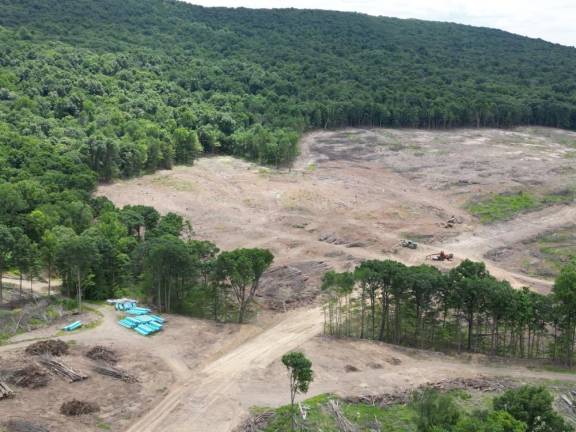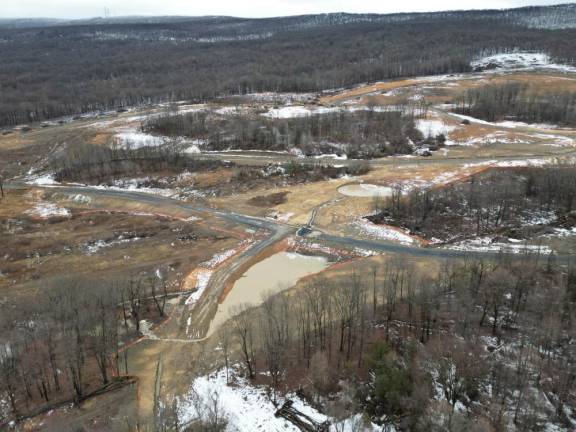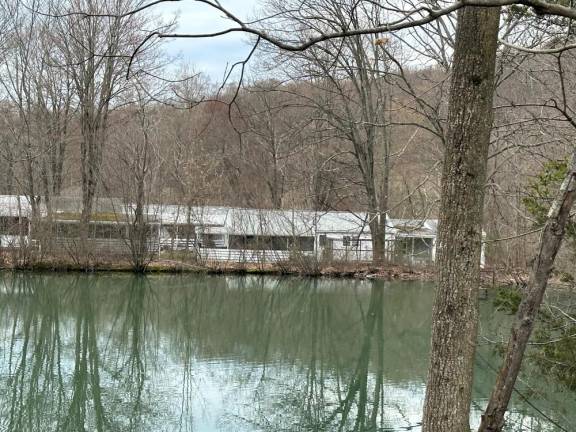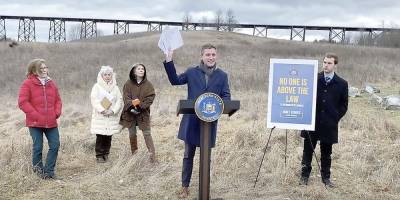DEC listens during 4 hours of Clovewood virtual public hearing
Blooming Grove. An overview of this controversial mega-development.



A project that has gone through nearly 15 years of major revisions and changes of ownership was the subject of over 100 letters sent to the Department of Environmental Conservation (DEC) from residents, prompting the DEC to take the unusual step of scheduling a virtual public hearing. Over 250 participants spoke during the more than four-hour hearing. Each speaker was limited to two minutes.
The proposed development, called “Clovewood,” is located at the foothills of Schunnemunk Mt. on Clove Road about a mile northeast of Route 208. It is technically in the village of South Blooming Grove, just before the village meets the border of the town of Blooming Grove. Portions are adjacent to state parklands and the County’s Gonzaga Park. The project has been in a bankruptcy agreement with a court judgement that states the developer, Keene Equities, must make regular payments while approvals are being sought. The current design calls for a 600-home layout, a number he says is necessary to make a profit on the project. Recently, village code was changed that would allow “accessory dwellings” with planning approval, bringing the potential unit number much higher and further affecting water and sewage rates.
Opposition vs support
Those opposing the project as designed cite the following issues of concern: 1.) “accessory dwellings” could double the unit total from 600 to 1,200; 2.) the estimated stats on water use and sewage effluent discharge into Satterly Creek (a seasonal creek prone to flooding during the rainy season and going dry during the summer; 3.) the broad clearcutting of trees, grading, and road construction without permits and disregard for numerous “stop work “ orders; 4.) destruction of protected timber rattlesnake habitat without permits; 5.) increased traffic on already congested commuter roads like Route 208; 6.) socio-economic impacts on existing residents; 7.) and the potential visual and financial impact to area trail systems and the associated eco-tourism industry (the Schunnemunk Trail will connect with the Long Path and a newly developing Highlands Trail link in Woodbury, and will enable a route from Orange County’s new Schunnemunk Rail Trail, beginning at the former Camp LaGuardia property in Chester and Blooming Grove and eventually connecting with the Appalachian Trail).
One advocate claimed there would be no negative effect on Route 208 traffic since scheduled changes to the light signal and road width will improve the traffic flow. But the degree of traffic from an increase of up to 1,200 additional residences each with two or more drivers, plus taxis, buses, and all kinds of service vehicles has yet to be determined.
Regarding the loss of timber rattlesnake habitats, the developers pointed out that the current plan sets aside 403 acres that will be protected rattlesnake habitat in perpetuity.
Support for the project was voiced by officials of the village of South Blooming Grove, about a dozen Hasidic residents, as well as a Hasidic group from Brooklyn echoing their need for more affordable housing. Village officials say they have corrected all violations issued by the DEC for their early work, including an incident where greenish-blue dye was illegally added to drainage water that overflowed into Satterly Creek and eventually to Moodna Creek in the center of the village of Washingtonville, both of which are used as drinking water sources. While residents were told that the dye was not toxic, concerned residents that get their drinking water from those creeks have not been able to find out the exact makeup of the dye.
Several Hasidic residents and officials stated they believe the opposition to be based in antisemitism and emphasized that they are simply furthering Governor Kathy Hochul’s goal of increasing affordable housing. Several other Jewish residents called in to say the opposition has nothing to do with religion, but rather whether laws and regulations are being broken, and the potential impact on the environment.
Other residents say they do not oppose housing, but that this plan is far too overwhelming for the small village and town that were named “Blooming Grove” because of their abundant natural resources and scenic views. They are also concerned about water resources and the altered viewshed of the Schunnemunk area.
Ongoing impact
Thousands of trees in the town and its villages have been clear-cut, along with associated vegetation, over the past two years. And numerous sites were clear-cut at the same time. Most of this deforestation has allegedly ignored buffer protections, and the leftover wood piles were left to dry out during the summer, creating a visual mess and a potential fire hazard.
Town planner Bonnie Franson also said the land layout does not show any of the necessary mitigation measures to address the development’s impact on the environment, except for the rattlesnakes (which she also felt were inadequate). She said, given what was presented, the permits must be refused.
The plan to discharge treated effluent into the Satterly Creek has two views as well. Residents who live along the creek as well as where it flows into the Moodna in Washingtonville say it’s simply unsuitable since the creek is intermittent, and that the cumulative drainage failures of both Clovewood and Prospect Gardens, plus this past year’s onsite overflows, don’t speak well for a solution that would satisfy residents with wells along the discharge route, especially since the dye that was added after last year’s issue flowed all the way into Washingtonville. Some said the water still has a greenish tint. But representatives for the village disagreed, and say that with their effluent treatment process, there will be no problem. A resident who has well water downstream suggested that a better resolution would be to send the effluent to the Harriman Treatment Plant.
Looking ahead
At this point, the data collected regarding the potential impact of this project to area resources is over five years old. Since then, population numbers have changed, along with the village’s carefully crafted Comprehensive Plan, which put a high priority on retaining its rural character. During the call, one resident suggested developing the project in phases that can be evaluated intermittently, before a minor problem becomes a major problem.
By the end of the nearly four-and-a-half-hour marathon hearing, it was clear that, by and large, speakers were not opposed to a housing development. Many seemed to indicate that they would accept a proposal for affordable housing, but not at 600 units, and not with accessory dwellings in the environmentally sensitive Schunnemunk Valley.
This story was originally published in the Orange County Courier Journal.

